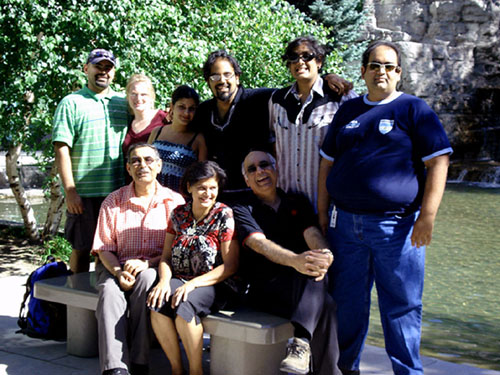Visitors exiting the Art Institute of Chicago on Michigan Avenue are often perplexed by the street sign that reads Swami Vivekananda Way.
What is it doing there? Who is this swami, and why does he deserve an honorary street name like Oprah Winfrey, Hugh Hefner and other Chicago legends?
Most Americans would not have a clue, but interfaith activists do, and Hindus do, and a great many yoga practitioners and students of Eastern philosophy do, and everyone in India certainly does.
And this year, millions more will learn why Vivekananda remains a revered figure more than a century after his passing. January 12th was the 150th anniversary of his birth, and celebrations and tributes are being held all year throughout India and much of the West.
The leading disciple of the legendary 19th century saint, Sri Ramakrishna, Vivekananda came to the U.S. in 1893 for the Parliament of the World's Religions, a 17-day festival in the midst of a huge world's fair called the Columbian Exposition.
He was an exotic sight in his orange robes and turban; very few Americans had even met a Jew or a Muslim at the time, much less a Hindu monk. Against all odds, the swami became an instant sensation, not as some carnival attraction but as a fresh, erudite voice that spoke with authority, in impeccable English, about his own tradition, religious harmony and the universal truths at the unseen depths of all religions.
He quickly encountered two types of Americans that are familiar to us all today: Christian supremacists who denounced him as a dangerous heathen preaching false religion; and open-minded, rational, spiritual seekers, who found his message and his demeanor irresistible.
He was, in a sense, the Jackie Robinson of spirituality, a bold and talented figure shattering widespread misconceptions and biases. Through word of mouth and adulatory press coverage, he became such a superstar that extra talks had to be scheduled for him to accommodate the crowds that flooded the amphitheater in the building that would later become the Art Institute. Hence, the location of Swami Vivekananda Way.
Because he was in demand on the lecture circuit, he remained in America longer than anticipated: more than three years in two separate trips. He passed away in India in 1902, and, like Mozart, Gershwin, and other rare shooting stars who never reached the age of 40, he produced a remarkable legacy in his few productive years.
In voluminous writings, some of which were converted from his numerous lectures, he articulated for the modern age the essential teachings of Vedanta, the philosophical system that stems primarily from the Bhagavad Gita and the Upanishads.
His four slim books on the principal pathways of Yoga -- karma(selfless action), bhakti (devotion), jnana (intellectual discernment), and raja (meditation and spiritual practice) -- became the authoritative descriptions of those categories, and to a large extent they remain so in today's yoga-saturated world because they set the tone for much of the subsequent commentary on the subject.
In America, Vivekananda's most enduring impact may be the organization he created to perpetuate his work. The Vedanta Society, which eventually established centers in most major U.S. cities, was the place for seekers interested in Hinduism, Indian philosophy, and yogic meditation in the early part of the 20th century.
Through its publications and the swamis who came from India to run the centers, it was the leading voice for what the title of one of its widely read anthologies called "Vedanta for the Western World."
A large percentage of the students drawn to later gurus, such as Paramahansa Yogananda and Maharishi Mahesh Yogi (who was also born on Jan. 12), were primed by the Vivekananda lineage.
In mid-century Vedanta Society swamis mentored some of the most prominent thinkers and writers in American history. If you've had transformative moments reading Joseph Campbell, Aldous Huxley or Huston Smith, or if you identified with the eccentric spirituality of J.D. Salinger's Glass family, you were touched by Vivekananda whether you realized it or not.
That 1893 gathering of religious leaders would probably not even be remembered if the token Hindu hadn't ignited such a fervent response.
Instead, it launched the modern interfaith movement and catalyzed an East-to-West transmission that has reshaped America's spiritual landscape. For those reasons and more, you will be hearing about Swami Vivekananda a great deal in the coming year, and so will people 150 years from now.
The above article is from the HUFFINGTON POST (Jan 12, 2013)




No comments:
Post a Comment